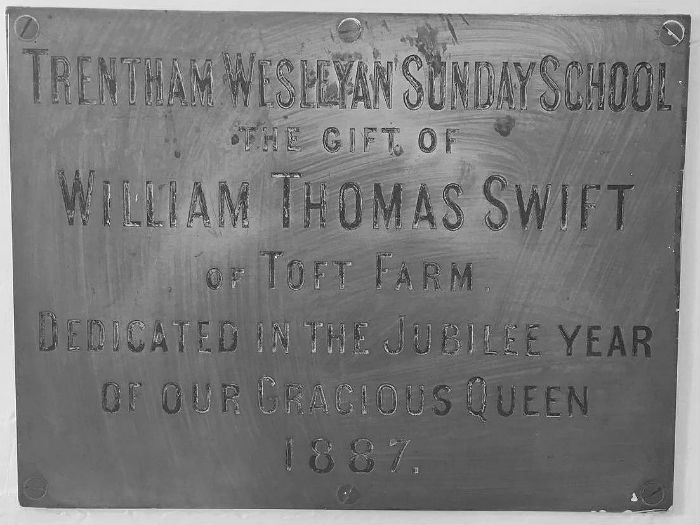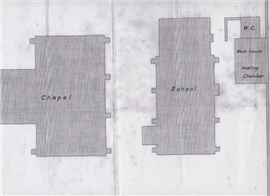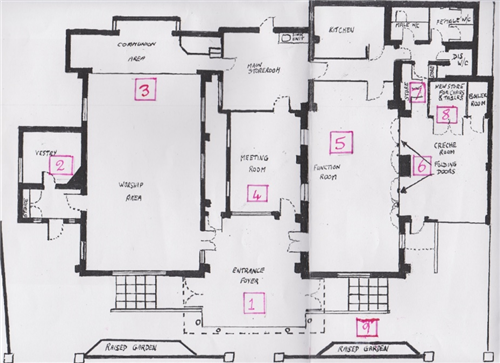Our History
This year we will celebrate 142 years of service, opening as a Wesleyan Chapel on 6 December 1883.
Methodist movement
The Methodist movement traces its origin to the evangelical awakening in 18th century Great Britain. Methodism followed from the work of John Wesley, who was an Anglican clergyman.
Wesley's visit to Staffordshire
John Wesley is known to have made the journey from Stafford to Newcastle as early as 1738. Perhaps he passed through Trentham? He visited Burslem in 1760. Perhaps workers from the Sutherland estate walked to hear him, came back and enthused to all who would listen? Fanciful conjecture maybe as little is known of the history, until about 1870 when meetings were held in Mrs Marrow’s cottage (on Longton Road close to Ash Green). In another cottage lived William Barnett, a carpenter in the employ of the Duke of Sutherland. In 1878 his cottage became a sanctuary for this fledgling church and was used to hold services in the front room and kitchen “to overflowing”. His first vision was to ask permission to expand his estate cottage or better still “a chapel of their own”.
Local Methodist society's bold move
The society was determined to hold an open air service on the village green (now a large roundabout at the entrance of Trentham Gardens). This was “an unheard of act” as the village was a ducal village and expected to follow traditional services. At the appointed time seven “dauntless Methodists” took their stand on Ash Green to the amazement of onlookers. They sang and they prayed and Mr Barnett preached “that Christ Jesus came into the world to save sinners.” This was seen in some quarters as a “piece of audacity”. An anonymous letter was sent to the preacher strongly condemning the holding of the service along with a threat that he would be driven out of the village unless “the movement speedily ceased”.
Church land and building costs
It was this letter that paved the way for a chapel. It was shown to the Duke of Sutherland and he expressed sympathy and promised a piece of land. The Duke’s architect Mr Roberts, himself a Methodist, drew up plans. The Duke allowed materials to be prepared by machines in his estate yard and generally gave his influence to the project. Even his son, the Marquis of Stafford, made a donation of £20. Foundation stones were laid on Thursday 17 May 1883 by Samuel Rathbone Edge and Sarah Newton Peacock. The church was opened on Thursday 6 December 1883 by Rev FJ Sharr and Rev J Baker with a Sunday School building opening four years later in 1887.
The church was built on land leased from the Duke of Sutherland - a 99 year term at £2-0s-6d per year for two and a half chains of land along Barlaston Old Road. When the Sunday School was added another was drawn up on Saturday 12 January 1884 with an additional £1-0s-2d charged on a 94½ year lease for the extra land. However no record can be found of any money paid. Signatures on the lease include the same William Barnett, an ancestor of a present church member.
The cost of the building was about £500 as was the Sunday School - considerable sums mostly to be borne by the society. Mr Swift gave a generous £200 on condition he must have space for his pony and trap.
Commemorative plaque in the Sunday School room
 Plaque reads: Trentham Wesleyan Sunday School - The gift of William Thomas Swift of Toft Farm - Dedicated in the Jubilee Year of Our Gracious Queen 1887
Plaque reads: Trentham Wesleyan Sunday School - The gift of William Thomas Swift of Toft Farm - Dedicated in the Jubilee Year of Our Gracious Queen 1887
Yet an article in The Methodist Recorder on Thursday 21 October 1909 mentions Mr TW Swift of Toft Farm (near Hanchurch) contributing £200 in memory of his late parents. Surely the same person?
Church in the early Twentieth Century
Records show that there were plenty of activities at the church on a Sunday. As well as a morning and evening service, Sunday school met TWICE - before the morning service and then again in the afternoon. A men’s bible study was also held in the afternoon. It was common for preachers to stay at Trentham for the whole day, conducting both services and speaking at the bible class – the meals provided for them were therefore well and truly earnt!

In 1906 there is a plan showing the addition of outdoor toilets to the left of the church and a wash-house to the right of the school room. Between 1911 and 1916 all the premises were valued by the Land Registry at £750 - less than the cost to build. Loyal service was undermined by the Great War and by movement of population.
The first world war brought changes and the number of church attendees suffered as a result of deaths in service during the war and subsequent population movement. Despite falling numbers there is evidence of faithful service from individuals who kept the church going. Records from the time give special mention to Mr. Coates (a local preacher), Mr Jolley (organist), Mr Proctor (Sunday School leader) and Mr Machin (Trustee and Secretary) during the 1920’s to 1940’s.
The 1930’s were to bring many changes in Methodism but Trentham seems to have ambled by “despite” (I would suggest because of) “faithful service by people of real character”. Gas lighting was changed to electric in 1932/33.
Second World War and beyond
The declaration of war on Sunday 3 September 1939 had an immediate impact with the conclusion of the evening service that day seeing the Home Guard take over the Sunday School rooms. Church attendance at this time was low, being typically 12 people for the morning service and perhaps 20-30 in the evening. As well as causing a shortage of preachers, the war stopped mid-week activities and led to evening services being held in the afternoon to ensure the ‘blackout was complied.’
In 1945 solid fuel heating in church was replaced. The end of the war and the 1950’s and 1960’s didn’t lead to an increase in church attendance with congregations being as low as five at the evening service. Closure of Trentham Methodist Church was never officially debated although must have been in people’s minds. Once more faithful and generous service was given by a few stalwarts giving rise to growth. In 1947 the River Trent flooded and the Sunday School was used as a day school. It still had the old black round stove for many years.
As late as 1965, church membership was just 27 people. However, the building of housing estates around Trentham combined with great efforts to promote Sunday School (Mr. Wise) and initiate both a Youth Club (Mr. Hooker) and Ladies Fellowship (Miss Edith Smith) started to have an impact. For example, Sunday School attendance rose to 90.
The growing numbers led to the decision to expand the premises. The individual church and school room were linked to provide an entrance foyer and additional rooms. The school room area was enlarged with toilets and a kitchen added. The church too was extended. There was an official re-opening and re-dedication on Saturday 10 July 1971 at 3:00pm and opened by Mr HB Hackney of Trentham. As detailed in the official programme of re-dedication “when older members have been questioned it has been a matter of regret that records are lost - and memories, though rich, are not always accurate in detail.”
The centenary of Trentham Methodist Church was celebrated in 1983. A booklet defining a programme of events for the year also included a letter of greeting from Elizabeth Sutherland, whose grandmother (Duchess Millicent) married the 4th Duke of Sutherland a year after the Methodist Church opened. The church then celebrated one hundred and twenty five years of worship in 2008. The last alterations were just ten years ago making a bigger kitchen and ensuring we were inclusive.

Modern lay-out of the church. Rooms 2, 3 and 5 relate to the original buildings. There is a new building programme envisaged for the future.
Our church today
In common with our history, the number of church members and attendees has continued to fluctuate, seeing 30-40 in worship at the morning service (before lockdowns). However, we remain committed, like those before us, to serve our local community through various fellowship activities and to share the message of Jesus to those who are interested in learning about our faith.
Thank you to Mr David Swann for the loan of history notes and priceless artefacts, especially an article published by The Methodist Recorder on 21 October 1909, entitled 'At the Gateway of the Potteries’ - A ducal village and its Methodism written by Mr TE Freeman.